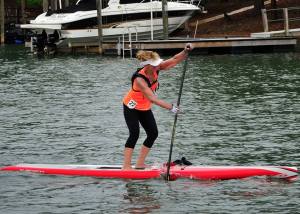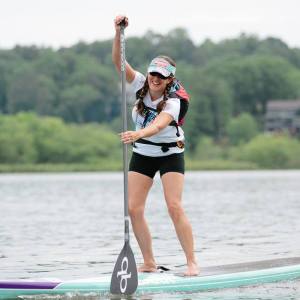I cannot express the depth of my gratitude to these tremendous ladies (Julia Nicholls and Dottie Hodges) for sharing their experiences with me. Their enthusiasm in and commitment to their communities is so genuine and inspiring. Listed below is only maybe 20% of what we discussed in our interviews. There is a lot more activity in these groups that could be compared with other community-related research and examined for potential usage in other fields (academia, marketing, etc). I continue to be a devoted and enthusiastic follower/onlooker/lurker in both online groups discussed below and am excited to see how they continue to grow into the future.
Introduction
In September, I had the pleasure of speaking with Dottie Hodges and Julia Nicholls – two stand up paddlers who have created vibrant online communities that facilitate group asynchronous fitness training. These groups were discussed briefly in my earlier post, Using Facebook Groups to Promote Online Learning Communities. The success of these paddlers and groups is exciting for many reasons:
- focus on online collaborative learning – that they are communities centered around learning and collectively building knowledge online
- low participation costs – how easy it is to participate in these groups despite their monumental group challenges
- they inspire action – how successful they are in inspiring continuous real world action when all community interaction exists online
- strong group identity – how enthusiastic their members are about the online communities
- steep growth – their phenomenal growth in membership and participation within a short time frame
In my post below, I share more about these communities and discuss reasons for their success based on current community-related theories.
100/100 Paddle Challenge
The 100/100 Paddle Challenge (100/100) is a Facebook group that unites a global community of paddlers in completing various distance related challenges. It is named after its first challenge – to paddle 100 miles in 100 days. The group was created by Julia Nicholls, a stand up paddler and former ultrarunner from Morehead City, North Carolina, as a way to encourage herself to train and paddle throughout the winter (personal communication, September 25, 2014).
(Julia Nicholls, 2014)
To participate in 100/100, group members log their miles paddled through posting on the group’s Facebook wall. The challenge simply encourages members to complete the miles in the designated time frame. How, when, and where a participant paddles these miles is unimportant, making the challenge available to participants of all skill levels, ages, and geographic locations.
100/100 was created in January of 2014. In its first month, the group had 31 members. In 10 months, the group has grown dramatically and now includes 311 members (Nicholls, 2014).
Back of the Pack Chattajack
Back of the Pack Chattajack (BOP) is an online community of paddlers who are mostly geographically separated but use a Facebook group to train together asynchronously. Dottie Hodges, the group’s founder and a Hammer Nutrition sponsored athlete, created the group after registering for the Chattajack – a 32 mile stand up paddle race on the Chattanooga River. As a former triathlete, Hodges had trained for other endurance-testing events through group workouts. In my interview with her, she explained that this sense of community is what motivated her in the past to stay engaged in her training and to compete. Through BOP, Hodges wanted to leverage this same group accountability and motivation through connecting online with other paddlers training for the Chattajack. (personal communication, September 25, 2014).
(Dottie Hodges, 2014)
Like 100/100, paddlers can participate in BOP through logging their training progress on the group’s Facebook wall. Although BOP does not require participants to train using a specific format, members use the group as a forum to share and gather information on workouts, racing gear, and nutrition. Because of the length of the race (32 miles), group members need to push themselves to paddle longer distances (20+ miles) as part of their training. For many participants, paddling these long distances is a challenge and results in muscle fatigue, mental exhaustion, and sometimes injury. Members use the group to share these challenges to obtain needed encouragement and feedback.
BOP was created in March of 2014, with 2 original members. This has also grown tremendously for the past 7 months, and now includes 53 members (Hodges, 2014).
Reasons for Success
Low Participation Costs, High Reward
Butler et al. explain in their 2014 research article that there is cost – in terms of time and energy – to participate in online communities. Members participate in these groups to obtain a specific benefit as a result of reviewing the discussion posts of other members. If reviewing these posts is time intensive, the participation cost of the group is high and may deter future participation (p. 704).
Although both 100/100 and BOP require tremendous physical and real-life action, participation online is very simple. Posts to the groups’ Facebook walls can range in length and detail, from paragraphs to just a few words, and include pictures. Pictures and short posts are easily scanned by other members, keeping the online participation cost in these groups relatively low.
As posts are added to the groups’ walls, other group members respond by “liking” and/or comments on the posts with words of encouragement. This positive reinforcement gives the group a very high team moral and encourages further interaction. The more content a participant adds to the wall, the more positive reinforcement he or she receives. Nicholls also regularly features member photos shared on 100/100’s wall as the main photo for the group’s page (Nicholls, 2014). This spotlight opportunity encourages members to continue sharing pictures of their paddling adventures.
Strong Group Identity
Ren et al. explain in their 2012 research article that “member participation and retention [in online communities] depends on member attachment” which is the “members’ affective connection to and caring for an online community” (p. 842). According to theories regarding group identity, a strong group identity can result in a strong member attachment. This group identity can be built through promoting common goals and group objects (like a flag or group symbol) (p. 844). Both 100/100 and BOP unite paddlers using both of these methods.
100/100 and BOP promote a specific challenge with milestones towards that goal that are easily tracked. Only participants who are commitment to completing these challenges (or enthusiastic onlookers like myself) are permitted to join the groups. This screening of potential members keeps the group focused and unified on its original goals and expectations.
Both groups also utilize a team logo and encourage members to display it with pride. Nicholls mails all 100/100 participants a sticker with the name of the group’s challenge. At the completion of their challenge, participants are encouraged to post and photograph this sticker in a prominent location. On the group’s Facebook wall are pictures of stickers stuck to paddles, boards, buoys, cars, computers, etc. (Nicholls, 2014).
(Williams, 2014)
Hodges designed a special logo for BOP to give the group a more professional and elite appearance (personal communication, September 25, 2014).
(Hodges, 2014)
This logo was featured as the main picture for the group’s Facebook page. Hodges later distributed t-shirts with this logo to group members at this year’s Chattajack (Hodges, 2014).
(Hodges, 2014)
Summary
Nicholls and Hodges have succeeded in building two impressive online communities organically through emphasizing group identity. Both 100/100 and BOP continue to be active communities because of the enthusiasm of their members in the content, and a structure that requires a low online participation cost. The success of these groups outlines research potential into the effects of peer encouragement on retention and participation in online communities.
References
Butler, B. S., Bateman, P. J., Gray, P. H., & Diamant, E. (2014). An attraction-selection-attrition theory of online community size and resilience. MIS Quarterly, 38(3), 699-728. Retrieved from http://www.misq.org/
Dottie Hodges [online photo]. (2014). Retrieved from https://www.facebook.com/dottie.b.hodges
Hodges, D. (2014, March 6). Back of the Pack Chattajack [Facebook Group]. Retrieved from https://www.facebook.com/groups/1404314579830164/
Hodges, D. (2014). Back of the Pack Chattajack Logo [online image]. Retrieved from https://www.facebook.com/groups/1404314579830164/
Hodges, D. (2014). Back of the Pack Chattajack T-shirts [online image]. Retrieved from https://www.facebook.com/groups/1404314579830164/
Julia Nicholls [online photo]. (2014). Retrieved from https://www.facebook.com/julia.nicholls
Nicholls, J. (2014, January 18). 100/100 Paddle Challenge [Facebook Group]. Retrieved from https://www.facebook.com/groups/682074028482292/
Ren, Y., Harper, F. M., Drenner, S., Terveen, L., Kiesler, S., Riedl, J., Kraut, R. (2012). Building member attachment in online communities: Applying theories of group identity and interpersonal bonds. MIS Quarterly, 36(3), 841-864. Retrieved from http://www.misq.org/
Williams, C. (2014). 100/100 Paddle Challenge Sticker [online photo]. Retrieved from https://www.facebook.com/cheryl.norcross




